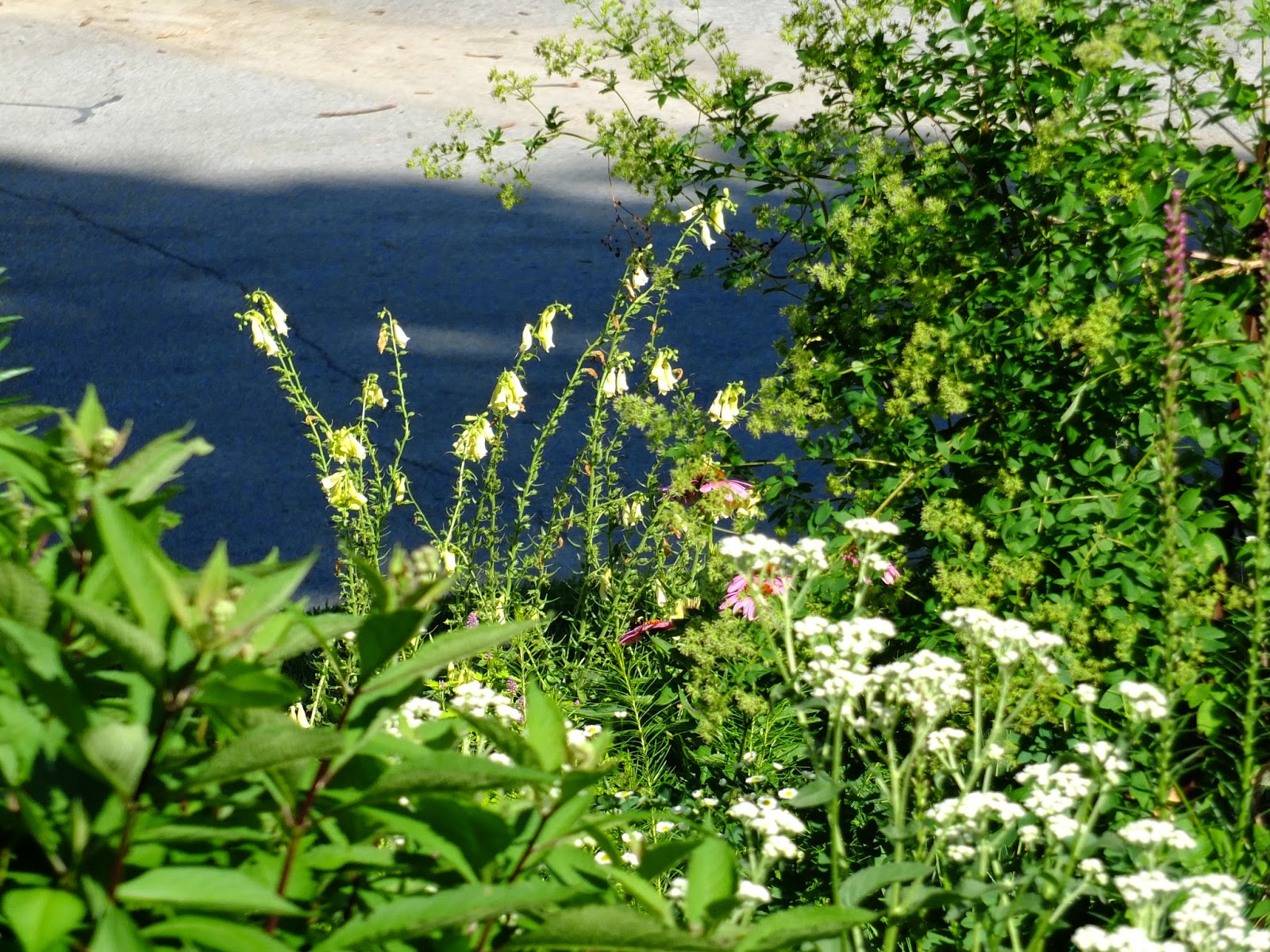For Gail's Wildflower Wednesday, I decided to first show the plants that are along the sidewalk going up to our house. Some are wildflowers, and some are not. In our yard, they grow right along side each other. There are also herbs, like the white blooming Winter savory.
Any marigolds you see in the front yard are heirloom volunteers that I don't remember the name of. I am seeing Whorled milkweed, Lead plant, coneflowers, Liatris, Wild quinine, Monarda, and maybe that is Little bluestem grass on the front left.
We are getting closer to the house, and the plant Gail posted on today, and what I want to feature for this post as well. Our mail carrier has been a good sport, with all of the plants leaning over the sidewalk. After taking the photos, I tied the Cup plant up so it would not lean into it as much.
Here's a closer view of Monarda fistulosa with a visitor.
The Meadow rue is taller than the Cup plant, but not as much as it appears in the photo, as there are some taller stems of the Cup plant behind it. This will be the third season for the plant here. It has spread, but it does not have room to spread much more.
Gail is in Tennessee, so I am assuming her Cup plant has been blooming longer than this one, which just opened its first bloom 2 or 3 days ago. The first year I had this plant, I deadheaded it because I was afraid it may start coming up in the neighbors' yards, and they could get upset about that. Last year, I went ahead and left them for the birds to eat, and did not get any volunteers here. I am curious to see if I do next year.
Here's a closer view of why they are called Cup plant. We had quite a bit of rain this season, and it was fun to see the water collected in the leaf "cups". I'm pretty sure these are aphids of some kind. I choose to leave them on for a meal for the critters who eat them. They aren't on every stem, otherwise I may choose to squish some of them, if I thought they would be a threat to the plant. I do not garden for perfect foliage, and use no pesticides.
Here's the view from the other direction. Now, the Cup plant is hiding the view of the Meadow rue a bit. Gail said that it prefers moist conditions. This does not get watered often, so maybe that will prevent it from spreading as much as it would with more moisture. The plant in front of it is a Golden alexanders that has gone to seed. I did have some of those come up this year.
Do you grow Cup plant? What are your experiences with it? I am wondering if it behaves a little differently in different zones. To learn more about it, go visit Gail's post.
Any marigolds you see in the front yard are heirloom volunteers that I don't remember the name of. I am seeing Whorled milkweed, Lead plant, coneflowers, Liatris, Wild quinine, Monarda, and maybe that is Little bluestem grass on the front left.
We are getting closer to the house, and the plant Gail posted on today, and what I want to feature for this post as well. Our mail carrier has been a good sport, with all of the plants leaning over the sidewalk. After taking the photos, I tied the Cup plant up so it would not lean into it as much.
Here's a closer view of Monarda fistulosa with a visitor.
The Meadow rue is taller than the Cup plant, but not as much as it appears in the photo, as there are some taller stems of the Cup plant behind it. This will be the third season for the plant here. It has spread, but it does not have room to spread much more.
Gail is in Tennessee, so I am assuming her Cup plant has been blooming longer than this one, which just opened its first bloom 2 or 3 days ago. The first year I had this plant, I deadheaded it because I was afraid it may start coming up in the neighbors' yards, and they could get upset about that. Last year, I went ahead and left them for the birds to eat, and did not get any volunteers here. I am curious to see if I do next year.
Here's a closer view of why they are called Cup plant. We had quite a bit of rain this season, and it was fun to see the water collected in the leaf "cups". I'm pretty sure these are aphids of some kind. I choose to leave them on for a meal for the critters who eat them. They aren't on every stem, otherwise I may choose to squish some of them, if I thought they would be a threat to the plant. I do not garden for perfect foliage, and use no pesticides.
Here's the view from the other direction. Now, the Cup plant is hiding the view of the Meadow rue a bit. Gail said that it prefers moist conditions. This does not get watered often, so maybe that will prevent it from spreading as much as it would with more moisture. The plant in front of it is a Golden alexanders that has gone to seed. I did have some of those come up this year.
Do you grow Cup plant? What are your experiences with it? I am wondering if it behaves a little differently in different zones. To learn more about it, go visit Gail's post.


















































